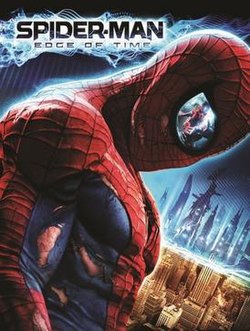Spider-Man: Edge of Time
 |
|
| Developer(s) |
Beenox (Wii, PS3, X360, 3DS) Other Ocean Interactive (NDS) |
|---|---|
| Publisher(s) | Activision |
| Distributor(s) | Marvel Entertainment |
| Writer(s) | Peter David |
| Composer(s) | Gerard Marino |
| Platform(s) | Nintendo 3DS Nintendo DS PlayStation 3 Wii Xbox 360 |
| Release | |
| Genre(s) | Action-adventure, platformer |
| Mode(s) | Single-player |
Spider-Man: Edge of Time is a 2011 video game developed by Beenox, based on the superhero Spider-Man. The game was directed by Gerard Lehiany. The story, written by Peter David, Ramiro Belanger and Gérard Lehiany, involves both Peter Parker, the original Spider-Man, and Miguel O'Hara, Spider-Man 2099. The game is considered the sequel to 2010's Spider-Man: Shattered Dimensions, although Spider-Man Noir and Ultimate Spider-Man are not featured, yet they are mentioned. Gameplay contains a "cause-and-effect" system in which one Spider-Man's actions will affect the other and vice versa. It was released on October 4, 2011 in North America and on October 14, 2011 in Europe. Edge of Time is the second Spider-Man title to be developed by Beenox, following Spider-Man: Shattered Dimensions of 2010, and the first released since Activision and Marvel's decision to make Beenox their lead developer on future Spider-Man games.
Spider-Man: Edge of Time, along with most other games published by Activision that had used the Marvel license, was de-listed and removed from all digital storefronts on January 1, 2014.
Gameplay in the game is very similar to gameplay in Shattered Dimensions. Upgrades are available for both Spider-Man and Spider-Man 2099. Upgrades are bought with XP (short for experience points), which can be earned by completing mini-challenges, such as defeating 30 enemies in two minutes. Including the traditional spider-sense, each Spider-Man has his own exclusive new ability. The original Spider-Man (Peter Parker) features a "hyper-sense" mode, which allows him to move quickly, pulverizing enemies one at a time or running through elaborate laser defence systems without getting hurt. Spider-Man 2099 can create a fake simulation of himself to divert an enemy, to either attack without them noticing or to move to another area unharmed while their attack destroys something in front of him, such as a highly secure lock.
The game begins with Peter Parker/Spider-Man battling Anti-Venom, who kills him. Rewinding back to the starting of the event, in the year 2099 Miguel O'Hara/Spider-Man 2099 investigates Alchemax scientist Walker Sloan. While spying on him, Spider-Man 2099 discovers Sloan plans to travel back in time to establish Alchemax years before its time, allowing him to rebuild the company in his own image and dismantle its corporate rivals before they are even established. Spider-Man 2099 arrives just as Sloan enters his Gateway, but jumps through the portal too late to stop him. Trapped in the portal, Spider-Man 2099 sees visions of the original Spider-Man being killed (though not by who). Being spit back into 2099, Miguel (unaffected due to being trapped in the portal) discovers Sloan's interference has reduced New York City to a horrifying dystopia. Miguel uses Peter Parker's DNA, stored within the company's archives, to create a chronal link with him, back in the present. (Peter's question if the "other me's" are in his head, suggests this takes place in the same continuity of Shattered Dimensions.) Spider-Man, now working for Alchemax in the genetics department instead of the Daily Bugle, is warned about his death on the 66th floor. However, Spider-Man refuses to obey his orders to flee if there's a psycho on the loose and travels to the 66th floor.
...
Wikipedia
